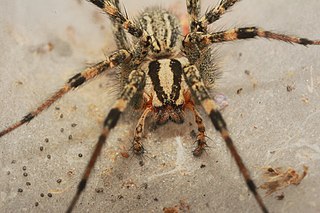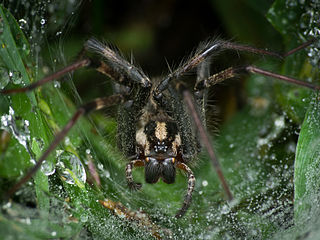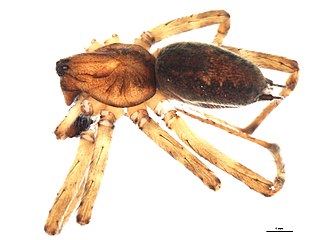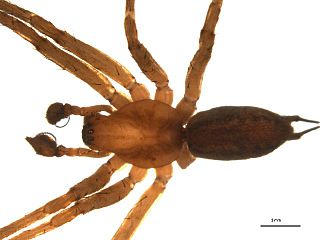
The hobo spider is a member of the genus of spiders known colloquially as funnel web spiders, but not to be confused with the Australian funnel-web spider. Individuals construct a funnel-shaped structure of silk sheeting and lie in wait at the small end of the funnel for prey insects to blunder onto their webs. Hobo spiders sometimes build their webs in or around human habitations. The hobo spider lays its eggs in September and they hatch during late spring. After the male hobo spider mates it dies.

Agelenopsis, commonly known as the American grass spiders, is a genus of funnel weavers first described by C.G. Giebel in 1869. They weave sheet webs that have a funnel shelter on one edge. The web is not sticky, but these spiders make up for that shortcoming by running very rapidly. The larger specimens can grow to about 19 mm in body length. They may be recognized by the arrangement of their eight eyes into three rows. The top row has two eyes, the middle row has four eyes, and the bottom row has two eyes. They have two prominent hind spinnerets, somewhat indistinct bands on their legs, and two dark bands running down either side of the cephalothorax.

The Agelenidae are a large family of spiders in the suborder Araneomorphae. Well-known examples include the common "grass spiders" of the genus Agelenopsis. Nearly all Agelenidae are harmless to humans, but the bite of the hobo spider may be medically significant, and some evidence suggests it might cause necrotic lesions. However, the matter remains subject to debate. The most widely accepted common name for members of the family is funnel weaver.

Lampshade spiders, family Hypochilidae, are among the most primitive of araneomorph spiders. There are two genera and twelve species currently recognized. Like mygalomorphs, most hypochilids have two pairs of book lungs, but like araneomorphs they have intersecting fangs, with the exception of some species which have chelicerae in an angle that is neither orthognathous or labidognathous. These long-legged spiders build typical "lampshade" style webs under overhangs and in caves. In the United States the fauna is primarily associated with the Appalachian, Rocky and California Mountains. Ten of the known species are found in these ranges, all in the genus Hypochilus. The genus Ectatosticta is found in China.

Agatoxins are a class of chemically diverse polyamine and peptide toxins which are isolated from the venom of various spiders. Their mechanism of action includes blockade of glutamate-gated ion channels, voltage-gated sodium channels, or voltage-dependent calcium channels. Agatoxin is named after the funnel web spider which produces a venom containing several agatoxins.

Agelenopsis aperta, also known as the desert grass spider or funnel-web spider, is a species of spider belonging to the family Agelenidae and the genus Agelenopsis. It is found in dry and arid regions across the southern United States and into northwestern Mexico. Their body is about 13-18 mm long and they have relatively long legs in order to run after their prey. Desert grass spiders can withstand very low temperatures even though they do not cold harden. It constructs the characteristic funnel-shaped webs in crevices where the funnel will fit, where they wait in the tube for prey which they can run after using their long legs. They often hunt for their prey at night.

The common American grass spider is a species of grass spider native to southeastern Canada and the New England states. It is sometimes also encountered in such states as Michigan and New York.

Hypochilus is a genus of North American lampshade spiders that was first described by George Marx in 1888.
Barronopsis is a genus of funnel weavers first described by R. V. Chamberlin & Ivie in 1941.
Tortolena is a genus of North American and Central American funnel weavers first described by R. V. Chamberlin & Wilton Ivie in 1941. As of April 2019 it contains only two species.
Schismatothele is a genus of South American tarantulas that was first described by Ferdinand Anton Franz Karsch in 1879.

Socalchemmis is a genus of North American false wolf spiders that was first described by Norman I. Platnick & D. Ubick in 2001. The genus name comes from a shortening of the phrase "Southern Californian Chemmis", as the genus was discovered in California.

Agelenopsis naevia is a species of funnel weaver in the family Agelenidae. It is found in the United States and Canada.
Clubiona kastoni, the kaston sac spider, is a species of sac spider in the family Clubionidae. It is found in the United States and Canada.

Agelenopsis potteri is a species of funnel weaver in the spider family Agelenidae. Native to North America, it has been introduced into Ukraine, Russia, and Kirgizstan.

Agelenopsis oregonensis is a species of funnel weaver in the spider family Agelenidae. It is found in the United States and Canada.

Agelenopsis emertoni is a species of funnel weaver in the family of spiders known as Agelenidae. It is found in the United States. The spider was named to honour arachnologist James H. Emerton. A. emertoni is distinguished from other Agelenopsis species in the genus by the male's loosely coiling embolus making more than one full circle, and a claw-like conductor tip. These features are sclerites of the male sex organ which is used to inseminate the female. The female has a distinctive conducting tube in her genitalia. The male can be between 6 and 13mm. Distribution is in the following states of the USA: Arkansas, Colorado, Florida, Georgia, Louisiana, Massachusetts, Mississippi, Missouri, New Jersey, New York, North Carolina, Oklahoma, Pennsylvania, Tennessee, Texas, Virginia.

Agelenopsis pennsylvanica, commonly known as the Pennsylvania funnel-web spider or the Pennsylvania grass spider, is a species of spider in the family Agelenidae. The common name comes from the place that it was described, Pennsylvania, and the funnel shape of its web. Its closest relative is Agelenopsis potteri.

Agelenopsis utahana is a species of funnel weaver in the spider family Agelenidae. It is found in the United States and Canada.

Socalchemmis kastoni is a species of false wolf spiders & wandering spiders in the family Zoropsidae. It is found in the United States and Mexico.














